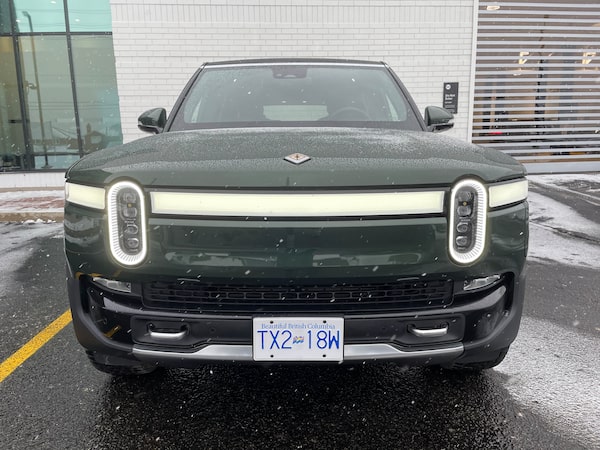
The Rivian R1S has funky, oval headlines on each side with a light bar across the front.The Globe and Mail
It’s been just over five years since the first customers reserved Rivian’s electric vehicles, and five years since I interviewed the company’s chief executive officer, R.J. Scaringe, at the Los Angeles auto show. There, in 2018, his automotive startup burst out of a self-enforced stealth mode with prototypes of the R1S SUV and R1T pickup.
They both looked good. Scaringe said at the time that investors had put half a billion dollars into the business thus far, roughly US$16-million of which went into purchasing an assembly plant in Normal, Ill. Getting to the start of production, he told me, would cost about US$2-billion. Cars would be in customers’ driveways by late 2020, he said, with a base price of US$72,500 for the quad-motor R1S.
Obviously, that didn’t happen.
Vehicles began trickling out of the factory in Illinois at the tail end of 2021, while Canadian deliveries began in late 2022. That year, the company spent US$6.4-billion more than it brought in. Customers in Ontario finally started getting their cars in December 2023.
And the price has gone up. Way up. The quad-motor R1S costs US$92,000. In Canada it’s $145,000. Even the basic dual-motor, standard-battery model costs $112,500.
My point is that making cars is a brutally hard and expensive business. Alongside Rivian, there was another EV upstart making waves in 2018 at the Los Angeles show. The company was called Byton, and the fact few people remember it is likely because it went bankrupt in 2021 without ever getting any cars into production, despite raising around US$1.2-billion.
The fact there’s now a quad-motor Rivian R1S with gleaming yellow brake calipers, panoramic glass roof and lovely open-pore wood trim now parked in front of me is a minor miracle. They did it. And it looks almost exactly like the prototype did five years ago.
Was it worth the wait? If you survey Rivian’s early customers, as Consumer Reports has done, you’ll find they’re an extremely satisfied bunch.
Build quality on my R1S tester is of a level some early Teslas could only dream of. The panel gaps are uniform. Even the motorized charge-port cover lines up perfectly.
Getting into the R1S, you’ll notice the floor is high – on account of the ample ground-clearance for off-roading and the huge 135-kilowatt-hour underfloor battery – and the roof isn’t especially tall. As a result, the door opening is weirdly short for such a big machine.
Once inside, there’s less headroom than in, say, a Range Rover but it still feels spacious for a family of four and all their luggage. Six adults would be a tight squeeze, but doable. The cabin has a warm, minimal design that matches Rivian’s gorpcore aesthetic. It’s as if Patagonia made an SUV.
The turn-signal sound is a pleasant blend of wolf’s howl and knocking on wood. When you lock the car using the keyfob – which is shaped like a mountaineer’s carabiner – the car makes the chirp-chip sound of a mountain bluebird recorded live in Yellowstone National Park. And you know what? It’s lovely.
For $145,000, though, drivers deserve more than nice materials and calming sounds; they deserve some proper physical controls on the dashboard. Digging through touchscreen submenus to adjust the air vents and side mirrors is so wrong.
On the road, the R1S is a strange mix of old and new. The view out over the flat, wide hood and narrow windshield brings to mind a nineties Jeep Grand Cherokee, but instead of a lazy V8, there’s instant, practically boundless electric power. Using only the top half of the pedal’s travel, the R1S is fast. Putting the pedal to the floor is borderline scary anywhere but on a wide, empty highway.
This quad-motor monster has 835 horsepower. That’s not a typo. Accelerating hard is like watching from the cab of a runaway freight train.
In a recent crash test, the three-tonne R1S tore through a metal guardrail like it was tinfoil, before smashing into and over a concrete barrier; the cabin looked almost unscathed, but the results led the researchers to call for a redesign of roadside barriers to accommodate ultraheavy EVs.
The Rivian rides on air suspension with McLaren-style hydraulically cross-linked dampers; they smooth out bigger bumps and potholes reasonably well, but do transmit every minor crack in the pavement up through the seats. And the off-road tires fitted to this particular R1S made for a noisy ride too.
None of these little issues amounts to a deal-breaker; if it sounds like I’m being overly picky, it’s only because this SUV costs $145,000. For all its faults, though, I came away largely impressed, just like the owners in Consumer Reports’ survey.
Is it worth $145,000? The new Range Rover is better in almost every way, but it’s a gas-guzzler, and it’s kind of predictable. I haven’t driven the three-row electric Kia EV9 SUV yet, but it’s roughly half the price and at least worthy of consideration.
It’s a shame, though, that the auto industry is making many of the same mistakes in the electric era as it did in the fossil-fuel one. For all the lovely nature sounds and kind-vibed branding, the R1S is a fairly traditional SUV – apart from the four electric motors and seemingly infinite power. Most electric SUVs, not just Rivian’s, are needlessly tall (read: dangerous and inefficient) and too fast for what they are, just like many of their gas-guzzling counterparts.
Rivian will soon unveil a smaller, cheaper model called the R2; let’s hope the brand uses its sophomore effort to push the EV envelope. The company proved it has the design and engineering ability to do so.
Tech specs
Rivian R1S Quad-Motor Large Pack All-Terrain
Price: $145,000 plus fees and taxes, including the luxury tax
Motor: Four motors
Battery: 135 kilowatt-hour (gross)
Power/torque: 835 horsepower/908 lb-ft
Drive: All-wheel drive, one motor per wheel
Power consumption (litres-equivalent per 100 kilometres): 3.6 city, 3.9 highway
Charging capacity: 217 kilowatts (approximate)
Curb weight: 3,175 kilograms (approximate)
Range (claimed / observed): 441 kilometres, N/A
Alternatives: Tesla Model X, Lucid Gravity, Kia EV9, or a gas-burning, three-row luxury SUV such as the Range Rover, Mercedes-Benz GLS, BMW X7 or Jeep Grand Wagoneer.
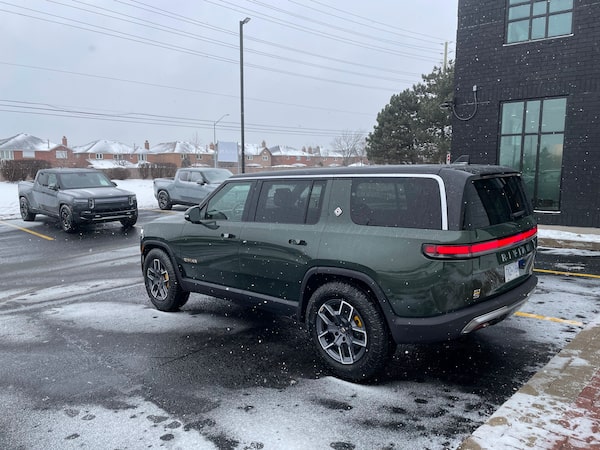
The Rivian R1S looks almost exactly like the prototype did five years ago.The Globe and Mail
Looks
Like a retro-future Jeep. It’s a conventional shape with funky lights and slick detailing. (See removable Bluetooth speaker, built-in air compressor, elegant colour and trim choices.)
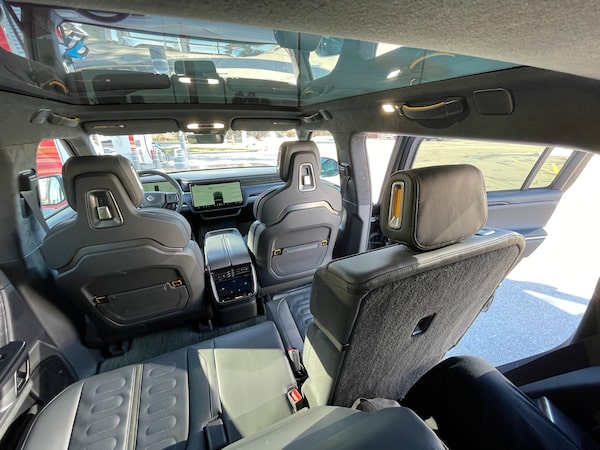
The panoramic glass roof.The Globe and Mail
Interior
Getting into the third row is a squeeze. Second-row legroom is decent, but gets cramped if you slide the seats forward to make space for third-row passengers.
Performance
Impressive as it is, accelerating from zero to 100 kilometres an hour in 3.1 seconds is too quick for a tall, three-tonne family vehicle. You simply shouldn’t be able to use this much power on public roads. Also, there’s something spooky going on with the handling. It’s subtle, but occasionally it almost feels as if the car is oversteering around corners, sliding the rear wheels, even though it’s not. Perhaps it’s a fine-tuning issue with the quad-motor setup.
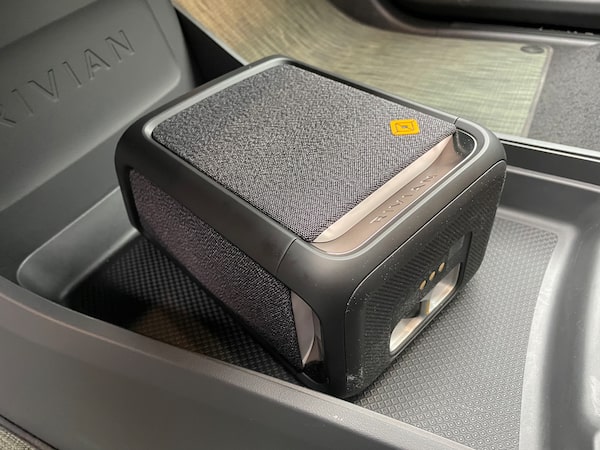
The car comes with a removable Bluetooth speaker.Matt Bubbers/The Globe and Mail
Technology
The stereo should sound better. There’s no Apple CarPlay or Android Auto, and Rivian isn’t planning on adding it. That would be okay if the built-in navigation app was better, but as in my tester, it’s buggy. There are a lot of little software issues the company is still ironing out, which isn’t surprising, given the newness of it all.
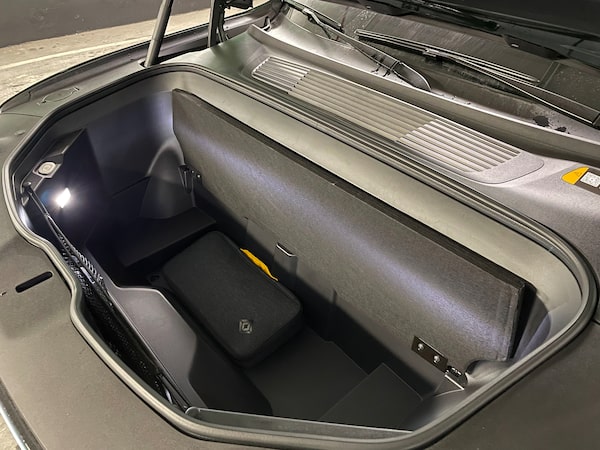
It has a large front trunk.The Globe and Mail
Cargo
There’s a deep front trunk, and a large split-opening trunk.
The verdict
A technological triumph that lacks imagination; a conventional SUV with a ridiculous amount of electric power; a satisfying, luxurious family-hauler that’s still a little rough around the edges.
Shopping for a new car? Check out the new Globe Drive Build and Price Tool to see the latest discounts, rebates and rates on new cars, trucks and SUVs. Click here to get your price.